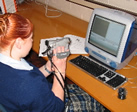Secondary 6
Software which supports visual learning techniques such as mind mapping and concept mapping is an invaluable tool in RE. All learners, especially pupils who have a preference for visual learning, benefit from expressing ideas, information and thinking using a combination of shape, colour, image, text and sound.
Although the terms are often used interchangeably, there is a difference between a mind map and a concept map. Mind maps deal with one main idea, whereas concept maps deal with several ideas. Both kinds of map help pupils to:
plan
clarify thinking
process information
organise ideas
see relationships and inter-relationships, and make connections
compare
recognise distinctions
think creatively
transform and reinforce learning
internalise and absorb new ideas
develop critical thinking skills
analyse
develop logical thinking.
The maps also help teachers to:
review learning and progress
identify misconceptions and incorrect links and connections.
Examples of visual learning software include the packages available from Inspiration Software and Mindjet. Pupils can work individually using the programs, or the teacher can use either a digital projector and computer, or an interactive whiteboard to involve the whole class in the software activities.
As the last unit for a project entitled ‘Why do we suffer?’ a Year 9 teacher used visual learning software to support pupils in preparing and writing an essay-style response to the following question:
‘A good god wouldn’t let suffering happen!’ How might religious or non-religious people respond to this statement?
The teacher used a digital projector and laptop in the classroom to involve all of the pupils in the activity.
By setting a framework using a concept map, the pupils began to plan a formal piece of extended writing containing:
a discussion/exploration of points for and against the proposition
an evaluation/conclusion.
The teacher invited the class to draw on their prior learning to suggest key points which might be relevant to the question - for example, the religions to be referred to, sources of authority and key terms.
One of the pupils recorded the class’s responses using the visual learning software on the laptop. This left the teacher free to encourage pupils to think about the issues raised by the statement. Through this, pupils came up with many ideas which were labelled and organised in the framework of the map. They then discussed further which points had greater value in supporting the question, and which should be rejected for inaccuracy or weakness of argument. Once the concept map was complete, the pupils worked individually to compose their own answer to the question, using the framework they had developed as a group.
In the following lesson, the pupils reviewed the concept map, together with their marked written work. The pupils could see and any ‘gaps’ in their written arguments and add the relevant information, such as additional/alternative examples, greater use of key terms and so on, to strengthen their work and help them achieve higher grades. The class then put the revised concept map on the school intranet as a resource for future use.
During this activity, pupils:
responded in an informed way to what some religious and non-religious people say about suffering, and gave their own views about the topic
analysed different arguments logically
developed their ability to structure and write a reasoned essay (extended writing)
used graphical representation of ideas to support decision-making about the relative strength of ideas and arguments.
How ICT enhanced teaching and learning
The visual learning software helped pupils to demonstrate their understanding of religious and non-religious responses to suffering, to appreciate common areas of understanding, and to make connections between sources of authority and the beliefs of the individual.
The use of ICT facilitated and stimulated discussion and debate, as there was a visual record for pupils to refer to while they were taking part in the class discussion. This provided a structure to their work which helped them to debate the question rationally.
The software enabled pupils to work in a more fluid and dynamic manner. Any new ideas and changes suggested by the pupils could be put on the map immediately, so they could see the positive results of their debate as it was taking place. The pupils then produced a ‘clean’ and agreed framework for the extended writing activity, which gave them increased confidence to complete the task.
The pupils were also able to review and revise the concept map alongside their marked written work. This ‘before’ and ‘after’ activity helped them in their personal target setting, as they could readily identify their areas of strength and weakness. The visual learning style appeals to pupils who find it difficult to recall work done using traditional methods of recording ideas.
The teacher was able to identify pupils’ misconceptions and any gaps in their knowledge and understanding, and to make judgements about progress and the needs of individual pupils for future lessons.
Links and resources
Places of worship on the Becta site - go
Cheshire RE: Starters and plenaries in religious education: Ideas for using mind and concept mapping activities as starters and plenaries in RE lessons at Key Stages 3 and 4 - go
Support 4 Learning: Education: Generic information on concept and mind mapping - go

